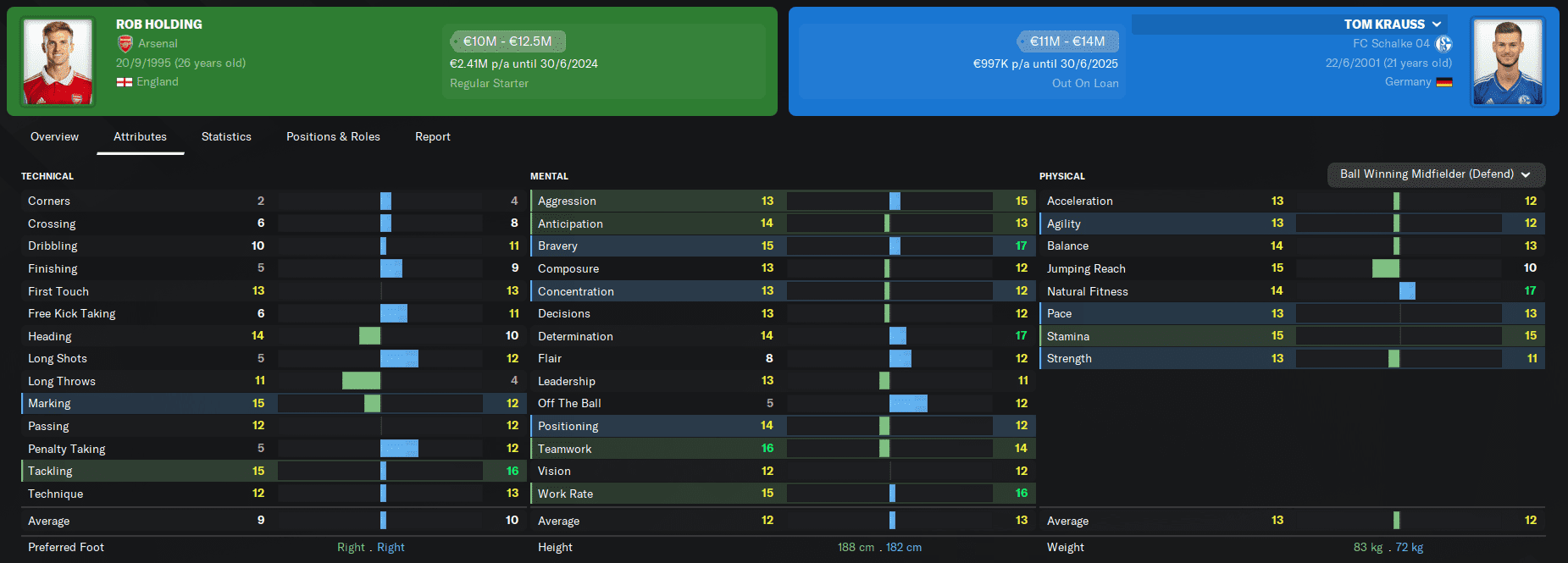Mastering Player Retraining: Unlocking Potential and Maximizing Squad Efficiency in Football Manager
There’s that song that goes, “You can't always get what you want, but if you try, sometimes you might find you get what you need”, and perhaps nowhere does it ring as true as it does on Football Manager. Particularly when you’re managing a side outside of the top leagues, it’s always a balancing act between what your side needs to improve, and what your economics, your reputation and the league rules allow you to get.
That is why sometimes you simply need to think outside the box and get to work to improve your side; if you can’t quite get what you need, you may have to get the next best thing and work around the problem. That’s when retraining players can become a useful tool to bridge the gaps in your squad, so let’s take a look at how to do it.
Look for the necessary attributes
The first step in any conversion is to make sure the player you want to retrain has got what it takes to make the transition. Whether you’re working with the players you’ve already got or looking to sign somebody, you should look for someone who already excels at the attributes required to play the new position.
That’s because, during the time that they learn their new spot and role, they player’s learning will be focused towards that, meaning development of other attributes will likely grind to a halt. Even more so, during the time that they play in this position, they will be absolutely clueless as to their new environment, so it will be their attributes that carry them during games. If you use a player who’s not quite ready for the conversion, you’re setting them to fail.
Another important thing is one of the hidden attributes: Versatility. You can usually find this in the player’s report, and it’s a key part of retraining players. A player with low Versatility will struggle to pick up a new position, and may not even get there after a long time working. Meanwhile, a player with high Versatility will pick it up much faster and will ease the transition. Even though you don’t need this to be the case (most players can pick up one or two new positions in a relatively short time), be very alert for low Versatility players as they may foil your plans.
Working for it
Another key part of retraining players is, obviously, training. You’ll want to take over control of this player’s individual training and set it to the position and role you want them to learn. This will help them develop their understanding of the new spot, and, even more so, give them familiarity in their new role, which will ease their performances on the pitch.
Try to stay off extra training like Additional Focuses or Traits learning, as this will slow down the process, and could make the player unhappy with training, which will also be detrimental to your objectives.
Additionally, it would be a good option to take over the General Training schedules, or at the very least, make sure you’re using routines that have players work on their Individual Roles, such as Attacking Movement, Defensive Shape, Match Practice, or those who focus on Goalkeepers for the rest of positions.
Gametime
It may seem obvious, but game time is one of the biggest factors when retraining a player into a new position. The effect training has only goes so far, so your players will need to get first-hand experience in games playing in their new position to fully learn it and develop.
However, they will prove a liability early on. Even if we’ve picked a good player to make the transition, and even if they have good Versatility, and even if you’ve been working on it during training, players will make mistakes. Usually, the threshold point is the “Competent” rating at any position, which they reach after getting 12 points in the attribute for that position.
Of course, you don’t want a liability player in your starting 11, particularly if you’re going up against a tough challenge, like after being promoted or after reaching continental competition for the first time. The obvious answer, in this case, is to focus this part of the work during pre-season. where the impact of bad decisions and mistaken moves is virtually meaningless, but what if you have to make the adjustment mid-season? A solid option would be to take advantage of international breaks and other breaks in the season to schedule friendlies. You can also have your player play in the u23 or Reserves in that position, as he’ll benefit from the playtime regardless of competition.
Conclusion
Retraining players in Football Manager is a great way of maximizing your team's potential and achieving success. As managers, we have the power to mould and develop our players, transforming them into versatile assets that can thrive in various positions on the pitch.
By identifying players' strengths, weaknesses, and their suitability for different roles, we can retrain them to fill gaps in the team or exploit new tactical approaches. The key lies in a thorough understanding of each player's attributes and potential, as well as their adaptability to different positions. This process demands patience, dedication, and a keen eye for detail. Patience is essential, as players may take time to adjust and master their new positions, and setbacks are inevitable. However, with consistent support and guidance, they will grow into the new roles, enhancing their skills and benefitting the team as a whole.





















